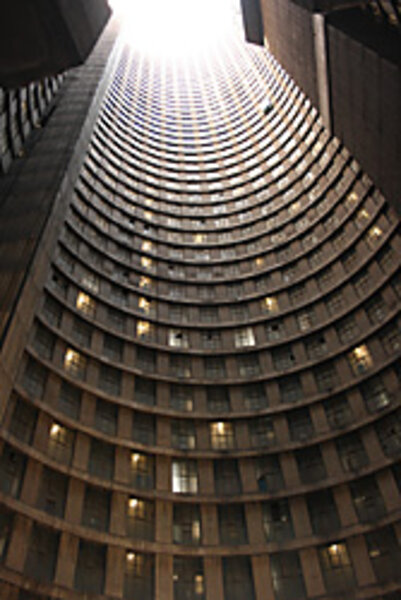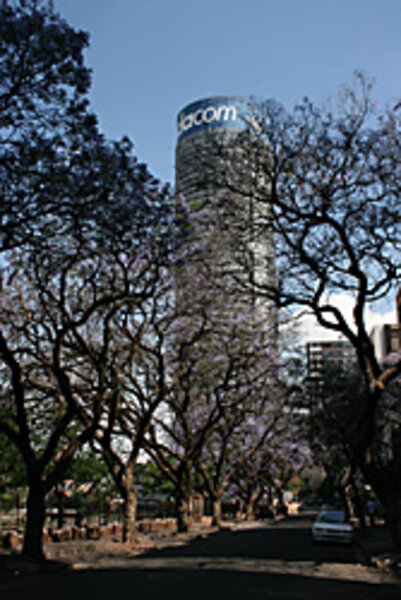Ponte City – a South African landmark – rises again
Loading...
| Johannesburg, South Africa
With bouncing step, Nour Addine Ayyoub walks toward what is known here as "the core."
"Don't look, don't look yet," he says. He stops and leans one elbow on a tired, rusted railing – the only barrier between him and a hundred-foot drop. He's grinning.
"OK," he says proudly. "Look."
Soaring upward is the empty, inner cylinder of one of South Africa's most famous structures: Ponte City, the tallest residential building in the Southern Hemisphere.
Fifty-four stories of dirty concrete and broken windows claw toward a circle of open air; pigeons swoop through the dimness. Below, seven stories, are the exposed, sloping boulders that make up the core's floor. Builders weren't able to blast away the rock to make a flat surface.
"So tell me," Mr. Ayyoub says, still smiling. "Does it make you think of Blade Runner?"
Well, yes. A strange comparison for a developer to make, perhaps – but for Ayyoub and codeveloper David Selvan, who are putting more than $12 million into the Ponte's rehabilitation, the plotline of life, death, and rebirth seems to hold appeal. And apparently this means no shying away from signs of the building's menacing past.
What about the rumor that people got pushed down the core during the 1990s when Ponte City became synonymous with African crime and urban decay?
"Oh I'm sure," he says. "It was Johannesburg."
• • •
Once, in the 1970s, Ponte was the place to live in Johannesburg, which people here called the New York City of Africa. It was on the edge of Hillbrow, a bustling, cosmopolitan neighborhood of artists and intellectuals where cafes and bookshops stayed open late and where, even under the tight rule of apartheid, interracial mixing was common.
"Hillbrow was really the center of life," recalls architect Rodney Grosskopff, who started designing the Ponte in 1973. After brainstorming with his colleagues, Mr. Grosskopff decided to make this new residential structure a cylinder – the first circular skyscraper in Africa, perched on a cliff-like peninsula overlooking downtown's main eastern artery.
"It would be a new thing, to go and build a round tower," he recalls.
He knew it had to be tall to fit all the units that the developers wanted, so he designed a 568-foot concrete and steel giant, adding a new focal point to the city's skyline. Because of bylaws requiring kitchens and bathrooms to have a window, he decided to leave an open, 32,000 square foot inner core, which let light into apartments from both sides. They put retail stores at the bottom and had plans to include an indoor ski slope on the core floor. They built saunas and chrome bars in all the penthouses.
"You can imagine my surprise when I went back to one of those penthouses [recently]," he says, "and there was still orange, shaggy dog carpeting – on the walls."
Then, in the 1990s, the end of apartheid in South Africa meant that anyone could move into the formerly whites-only downtown. Hillbrow, one of the "gray areas" where both races lived and worked, became an epicenter for this newfound freedom. But soon, white flight, employment shortages and a flood of jobless immigrants from other African countries set the neighborhood – like the rest of downtown Johannesburg – into an economic tailspin. Crime rates soared.
Many downtown building owners gave up on their properties when they weren't able to collect rent from tenants, or couldn't control the crowds of people forcing their way into each apartment. Some apartment complexes were "hijacked" by gangs who blocked owners from entering and forced tenants to pay them instead.
By the mid '90s, Hillbrow's murder and rape rates were worse than almost any place in the world. Ponte City's owners hadn't stepped foot in the building for years, and rubble piled up five stories high in the core. Despite the expansive views from every unit, the building was better known for rats, guns, drugs, and violence. Ponte City's notoriety even spilled into the literary world – German novelist Norman Ohler centered his book, "Stadt des Goldes," on Ponte, telling the violent story of a young woman who falls in love with a Nigerian drug lord who lives there.
• • •
Manny da Costa is the type of buyer Ayyub wants to see here. He's lived in the city his whole life, he and his wife, Maria, are empty nesters ready to downsize from their expansive home in one of the city's leafy residential neighborhoods.
"When it was launched many years ago, this was the elite place in Hillbrow," Mr. Da Costa says. "Now maybe the wheel turns.... And it might sound strange to you, but there would be something nice about owning a piece of the tallest residential building in Africa."
Da Costa stands on the 32nd floor in one of the model furnished apartments entitled "Global Fusion." This is the only finished floor of the building, with a super mod, blue-light lit corridor and six model apartments. Developers are selling all of the units furnished, in styles that range from "Future Slick" – all red, black, and chrome minimalist – to "Glam Rock," with velvet, '60s-patterned furniture. The apartments sell from $80,000 to $150,000.
Da Costa doesn't mind that Hillbrow is still considered one of the most dangerous neighborhoods on the continent – most of that, he says, is perception. And moreover, he says, the building itself seems safe – because of its position on the rocky outcrop, and because of the way the entrance road is built, the Ponte is almost a fortress.
Mrs. Da Costa runs her hands over the apartment's granite kitchen island: "This is perfect. It's lock up and go. And eventually, they'll have everything right here."
Ayyoub nods. He has big plans for making the Ponte a community, with an indoor climbing center at the base of the core, a huge child-care center, restaurants, and spas. The Virgin Atlantic gym chain has committed to building a large facility on one of the bottom levels; restaurants are vying for space.
The city's development agency is upgrading the area directly around Ponte, in part as a general urban renewal effort, in part to prepare for the 2010 soccer World Cup, to be hosted by South Africa. Ponte City is only blocks from one of the main World Cup stadiums – some apartments look right down onto the playing field.
This has also been a big selling point, Ayyoub says: Between investors and individual buyers, 269 of the available 311 apartments sold on the Ponte's launch date in October.
"When we opened this to the public, 500 people drove here," he says. "They all saw it, they all understood."
He peers down into the gray light of the concrete core – a move that can make one's stomach lurch. "You can already see it, feel it," Ayyoub says. "Look at this, it's amazing."






